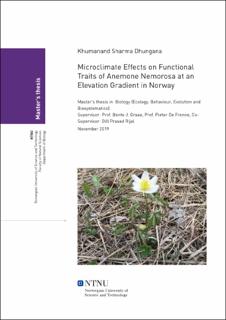| dc.description.abstract | Abstract
Microclimatic gradients have a large influence on population growth rates of species and limit their distributions. Assessing changes in plant functional traits along microclimatic gradients is useful for understanding the drivers of climate responses in species and the mechanisms related to such responses. For instance, changes along climatic gradients may relate to temperature, moisture, or to associated drivers such as light or competition, and they may be caused by limitations in growth, reproduction or survival, which again reflected in changes in the functional traits. To understand, how microclimate along elevation and forest gradient affect plant functional traits, we selected a slow colonizing forest herb Anemone nemorosa as a model plant. This thesis combines observational and semi-experimental approaches to answer the following questions: (1) How is growing degree hours and light can be affected along the elevation and forest gradient as well as competition treatment? (2) Does competition along elevation and forest gradient have an effect on the performance of A. nemorosa? (3) Do microclimatic factors (light and temperature) have an effect on the functional traits of A. nemorosa along different elevations. We measured plant functional traits of A. nemorosa and microclimate and soil variables from three different elevations and along the forest gradients in deciduous forests in Central Norway. We used linear mixed effect model to find the answers to all our research questions.
We found that GDH and mean light intensity decreased towards the interior of the forest. We observed higher GDH in plots without other competitors compared to those that had other competitors within the plots. Plant height and leaf dry matter content increased at higher elevation and towards forest interior and when competitors were removed, while plant biomass and specific leaf area decreased at higher along elevation and towards forest interior and when competitors had been removed. GDH negatively affected plant height and LDMC but positively affected SLA and plant biomass. Surprisingly, the light did affect to functional traits of A. nemorosa. We conclude that taller Anemone with lower SLA, higher LDMC, and lower plant biomass was present at a higher elevation performed better and seems to adapted in higher elevation. Likewise, increased Anemone height at forest interior indicated positive adaptive strategies under canopy. Likewise, shorter Anemone with higher specific leaf area, in competition plots, indicated weak competitors’ forest outside, at forest edge and near to forest edge.
Key words: Anemone nemerosa, functional trait, competition treatment, plant performance. | |
